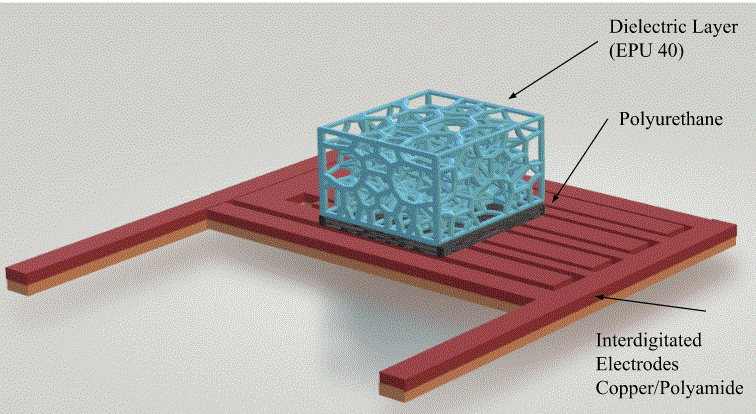3D-Printing Capacitive Sensor
Skills Utilized:
- Mechanical tests
- CAD design
- Mechanical deformation simulations with Matlab and Abaqus
Purpose: It has been shown that creating microstructures within the dielectric layer in a capacitive sensor can significantly improve capacitance and sensitivity response. Previous microstructure manufacturing methods dependent on molding are limited in tunability and consistency. Using Continuous Liquid Interface Production (CLIP), we aim to fabricate a tunable and reproducible lattice microstructure and characterize its mechanical and capacitance response.
2022-2023
Project Schematic

Simulation
Skills Utilized:
- Abaqus SIMULIA
- Fusion 360
Purpose: Studying microstructure lattices of types: tetrahedral, voronoi, rhombic, and kagome. Simulation is crucial in understanding how force is distributed through the struts of the lattice. How lattices deforms under stress largely dictates the capacitance response of interdigtated sensors.

Abaqus simulated surface stress distribution of unit cells under 5N with periodic boundary conditions applied

Derived from Abaqus simulation. Used MatLab to turn inp files into odb files with periodic boundary conditions applied

Abaqus simulated surface stress distribution of unit cells under 5N with periodic boundary conditions applied
Building controlled compression plate
Skills Utilized:
- Arduino + IDE
- Laser Cutting, Soldering, Wiring Breadboard
Microcontroller test
Skills Utilized:
- Abaqus SIMULIA
- Fusion 360
Purpose: We needed to find a way to analyze strut deformation of lattices under a controlled amount of force. One method is making a compression device that can adjust the force magnitude. By using an Arduino force sensor & a compression plate design, we can adjust the force applied. The criteria are that the system has to fit in a Micro CT machine for imaging--to visualize strut deformation--and has to be transparent to not deflect the x-rays


Describe your image

Mechanical Testing
Skills Utilized
- Compression tests
- Computing stress and strain data
Purpose: to understand the mechanical properties of our lattices, we performed compression tests to analyze how each type of lattice strains in response to stress


Describe your image



-1.png)